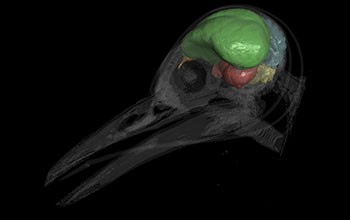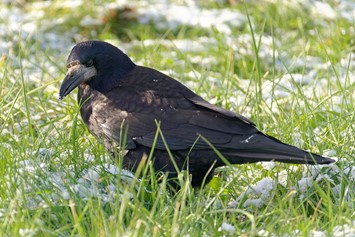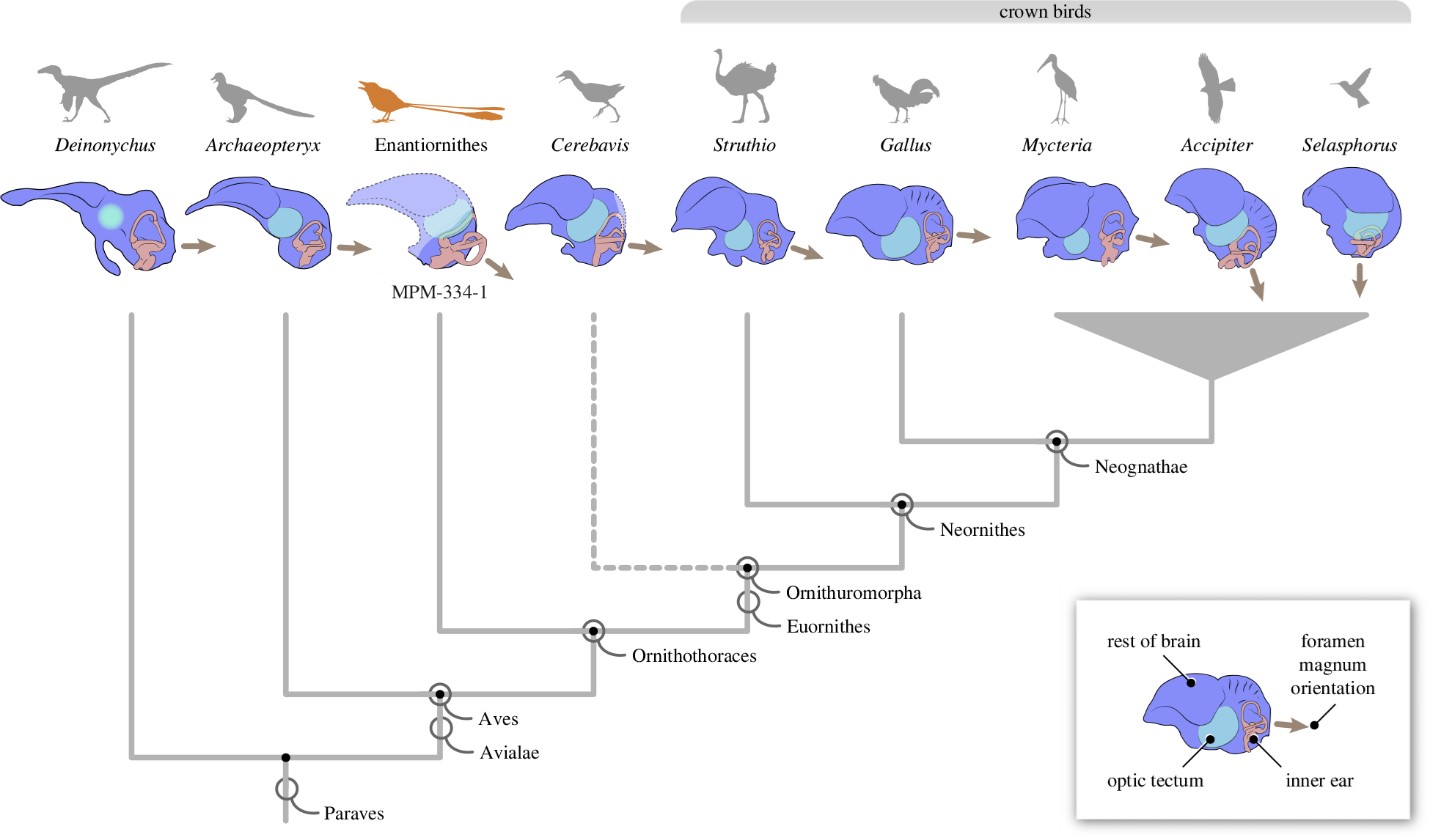
Credit: A. Blanoff, American Museum of Natural History
Background
Synopsis: Birds are known for their smarts and flight skills. Scientists believe a part of their brain called the cerebellum helps control flight. While bird brain evolution is well studied, how the cerebellum grew so large is still unclear, but new fossils may offer clues.
- Though the phrase “bird brain” is used as an insult, birds are actually quite intelligent.
- Modern birds have relatively large brains that fit snugly within their skulls, with brain-to-body size ratios similar to those of primates.
- Birds also have advanced cognitive abilities. Many can mimic human language and solve complex puzzles.
- Their intellectual capacity is on par with that of mammals.
- In addition, their brains control highly specialized flight behaviors such as takeoff, landing, gliding, soaring, hovering and diving.

Corvids are often considered the smartest birds. They have excellent memory and can use tools. For example, rooks, like the one pictured above, learned to drop rocks into a bottle to raise the water level to drink.
Credit: Jakub Halun, CC BY 4.0, via Wikimedia Commons
- The cerebellum of modern birds is likely what allows them to fly so precisely.
- The cerebellum is the brain region responsible for motor control, coordination and spatial awareness.
- Researchers theorized it played a key role in bird flight, but they lacked solid evidence.
- That changed when scientists monitored the brain activity of pigeons before and after flight.
- Using PET imaging, they observed significantly increased activity in the cerebellum and the neural pathways that lead from it to the eyes.
- Though not yet conclusive, this and other studies suggests the cerebellum helps control flight.
- Fossil records reveal how the bird brain sizes evolved in relation to body size.
- CT scans and shape analysis of modern and extinct bird skulls show that the brain-to-body size ratios evolved differently in birds than in their close relatives, dinosaurs and alligators.
- This suggests that birds followed a unique evolutionary path.
- At the mass extinction of non-avian dinosaurs, a group of birds called the Neoaves evolved to fill open ecological niches. They maintained large brains while reducing body size, increasing their brain-to-body size ratio.
- As the Neoaves diversified, larger species like hawks and falcons evolved more slowly, with their bodies increasing in size faster than brain size.
- In contrast, birds like crows and parrots continued to grow larger brains relative to their bodies, resulting in higher brain-to-body size ratios.
- Island birds also retained larger brains, likely because of unstable and demanding environments.
- Nocturnal and insect-eating birds tend to have bigger brains as well, possibly due to their reliance on smell and touch.

This family tree shows how bird brains and ears changed over time. One ancient bird had features like today’s birds, which helped with flying and balance.
Credit: Guillermo Navalón, Daniel J. Field, CC BY 4.0, via Wikimedia Commons
- How birds evolved a cerebellum capable of modern flight is still unclear, but early fossils are shedding light on the mystery.
- Paleontologists studying maniraptorans, a group of dinosaurs that eventually gave rise to birds like Archaeopteryx, have found increased cerebellum size and folding in their brain tissue, important signs of advancing motor control.
- In Brazil, scientists discovered a new species from the extinct enantiornithine bird, Navaornis hestiae. The bird had complex feathers and could fly, though not as efficiently as modern birds.
- Its well-preserved skull allowed researchers to digitally reconstruct its brain, revealing a blend of primitive and advanced traits.
- A CT scan and reconstruction of its skull also revealed a large cerebrum (used for cognition) but a smaller cerebellum, which may explain its more limited abilities.
- This fossil may represent an intermediate between Archaeopteryx, the oldest known bird, and today’s birds.
- This suggests that brain evolution in birds may have occurred step by step, with cognitive regions developing before the parts responsible for refined flight control.
- These fossil discoveries continue to reshape what we know about how bird brains evolved. As more ancient species are uncovered, scientists move closer to understanding how intelligence and flight developed in modern birds.
Episode script
Birds have very large brains for their body size. New research is helping scientists understand how they work, and came to be.
One part of a bird’s brain, the cerebellum, controls their amazing flight capabilities – their spatial awareness, allowing sudden direction changes through tree branches, or their ability to chart migration over thousands of miles.
PET scans taken pre- and post-flight have shown very high brain activity in the cerebellum, especially the neural pathways connected to the eyes.
CT scans of the skulls of modern birds and their fossil ancestors help explain how their brains evolved.
The brains of early birds stayed the same size, as their bodies shrank. The brains of many bird families, like crows and parrots, then began to grow even larger.
Island, nocturnal and insect-eating birds also grew larger brains, to manage difficult environments and chase flying prey.
To control what birds do when not flying—building elaborate nests, singing complex songs, even solving puzzles—requires another part of the brain: the cerebrum.
Other early bird fossils show that the cerebrum grew in size first, while the sophisticated flight anatomy, and the cerebellum to control it, developed later.
Taken together, their cerebrum and cerebellum make a remarkable brain, which gives birds their even more remarkable qualities.
So if anyone ever calls you a bird brain… well, say thank you!

